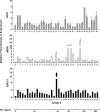Multidrug Transporters and Alterations in Sterol Biosynthesis Contribute to Azole Antifungal Resistance in Candida parapsilosis
- PMID: 26169412
- PMCID: PMC4576097
- DOI: 10.1128/AAC.01358-15
Multidrug Transporters and Alterations in Sterol Biosynthesis Contribute to Azole Antifungal Resistance in Candida parapsilosis
Abstract
While much is known concerning azole resistance in Candida albicans, considerably less is understood about Candida parapsilosis, an emerging species of Candida with clinical relevance. We conducted a comprehensive analysis of azole resistance in a collection of resistant C. parapsilosis clinical isolates in order to determine which genes might play a role in this process within this species. We examined the relative expression of the putative drug transporter genes CDR1 and MDR1 and that of ERG11. In isolates overexpressing these genes, we sequenced the genes encoding their presumed transcriptional regulators, TAC1, MRR1, and UPC2, respectively. We also sequenced the sterol biosynthesis genes ERG3 and ERG11 in these isolates to find mutations that might contribute to this phenotype in this Candida species. Our findings demonstrate that the putative drug transporters Cdr1 and Mdr1 contribute directly to azole resistance and suggest that their overexpression is due to activating mutations in the genes encoding their transcriptional regulators. We also observed that the Y132F substitution in ERG11 is the only substitution occurring exclusively among azole-resistant isolates, and we correlated this with specific changes in sterol biosynthesis. Finally, sterol analysis of these isolates suggests that other changes in sterol biosynthesis may contribute to azole resistance in C. parapsilosis.
Copyright © 2015, American Society for Microbiology. All Rights Reserved.
Figures



Similar articles
-
Resistance Mechanisms and Clinical Features of Fluconazole-Nonsusceptible Candida tropicalis Isolates Compared with Fluconazole-Less-Susceptible Isolates.Antimicrob Agents Chemother. 2016 May 23;60(6):3653-61. doi: 10.1128/AAC.02652-15. Print 2016 Jun. Antimicrob Agents Chemother. 2016. PMID: 27044550 Free PMC article.
-
Activity of Isavuconazole and Other Azoles against Candida Clinical Isolates and Yeast Model Systems with Known Azole Resistance Mechanisms.Antimicrob Agents Chemother. 2015 Oct 19;60(1):229-38. doi: 10.1128/AAC.02157-15. Print 2016 Jan. Antimicrob Agents Chemother. 2015. PMID: 26482310 Free PMC article.
-
Analysis of global antifungal surveillance results reveals predominance of Erg11 Y132F alteration among azole-resistant Candida parapsilosis and Candida tropicalis and country-specific isolate dissemination.Int J Antimicrob Agents. 2020 Jan;55(1):105799. doi: 10.1016/j.ijantimicag.2019.09.003. Epub 2019 Sep 11. Int J Antimicrob Agents. 2020. PMID: 31520783
-
[Azole resistance in Candida spp].Nihon Ishinkin Gakkai Zasshi. 2003;44(2):87-92. doi: 10.3314/jjmm.44.87. Nihon Ishinkin Gakkai Zasshi. 2003. PMID: 12748589 Review. Japanese.
-
Screening for amino acid substitutions in the Candida albicans Erg11 protein of azole-susceptible and azole-resistant clinical isolates: new substitutions and a review of the literature.Diagn Microbiol Infect Dis. 2010 Apr;66(4):373-84. doi: 10.1016/j.diagmicrobio.2009.11.006. Diagn Microbiol Infect Dis. 2010. PMID: 20226328 Review.
Cited by
-
Antifungal Resistance and Genotyping of Clinical Candida parapsilosis Complex in Japan.J Fungi (Basel). 2023 Dec 20;10(1):4. doi: 10.3390/jof10010004. J Fungi (Basel). 2023. PMID: 38276020 Free PMC article.
-
The efflux pump inhibitor tetrandrine exhibits synergism with fluconazole or voriconazole against Candida parapsilosis.Mol Biol Rep. 2019 Dec;46(6):5867-5874. doi: 10.1007/s11033-019-05020-1. Epub 2019 Aug 12. Mol Biol Rep. 2019. PMID: 31407245
-
Evaluation of Molecular Epidemiology, Clinical Characteristics, Antifungal Susceptibility Profiles, and Molecular Mechanisms of Antifungal Resistance of Iranian Candida parapsilosis Species Complex Blood Isolates.Front Cell Infect Microbiol. 2020 May 21;10:206. doi: 10.3389/fcimb.2020.00206. eCollection 2020. Front Cell Infect Microbiol. 2020. PMID: 32509592 Free PMC article.
-
Triazole Evolution of Candida parapsilosis Results in Cross-Resistance to Other Antifungal Drugs, Influences Stress Responses, and Alters Virulence in an Antifungal Drug-Dependent Manner.mSphere. 2020 Oct 28;5(5):e00821-20. doi: 10.1128/mSphere.00821-20. mSphere. 2020. PMID: 33115837 Free PMC article.
-
Threats from the Candida parapsilosis complex: the surge of multidrug resistance and a hotbed for new emerging pathogens.Microbiol Mol Biol Rev. 2024 Dec 18;88(4):e0002923. doi: 10.1128/mmbr.00029-23. Epub 2024 Nov 7. Microbiol Mol Biol Rev. 2024. PMID: 39508581 Review.
References
-
- Lockhart SR, Iqbal N, Cleveland AA, Farley MM, Harrison LH, Bolden CB, Baughman W, Stein B, Hollick R, Park BJ, Chiller T. 2012. Species identification and antifungal susceptibility testing of Candida bloodstream isolates from population-based surveillance studies in two U.S. cities from 2008 to 2011. J Clin Microbiol 50:3435–3442. doi:10.1128/JCM.01283-12. - DOI - PMC - PubMed
Publication types
MeSH terms
Substances
Grants and funding
LinkOut - more resources
Full Text Sources

